
The
Obelisks of Rome
The locations of all places are shown on my Google-Earth Map
Google-Maps (increase the magnification this map is in 3-D)
The Romans have
been obsessed with obelisks already during imperial and later during
Papal times. No other nation owns so many obelisks. In fact there are
now more than twice as many obelisks standing in Rome as remain in
Egypt. All fell after the Roman period except for the Vatican obelisk
and were reerected in different locations.
The
city of Rome harbours eight Egyptian and five Roman obelisks together
with a number of more modern obelisks; there was also formerly (until
2005) an ancient Ethiopian obelisk in Rome:
At
least eight Egyptian obelisks (1-8) were taken from Egypt after the
Roman conquest and brought to Rome.
Another five obelisks
(9-13) were manufactured in Egypt in the Roman period at the request
of the wealthy Romans, or made in Rome as copies of ancient Egyptian
originals
For the transport down the Nile to Alexandria and
from there across the Mediterranean to Rome, special heavy cargo
carriers, the Obelisk ships, were used by the Romans. On site, large
Roman cranes were employed to erect the monoliths.
Text and Photos from Wikipedia
This may seem like a boring chapter, but even if one disregards Sigmund Freud chuckling in Heaven, the efforts by uncounted Emperors and Popes to erect so many elegant but blatantly phallic symbols of their power is an aspect of Rome to think about....
Original Egyptian Obelisks
1.
Lateranense
In
front of the Lateran Palace, 357,
1588
32.2
m

The tallest obelisk in Rome and the largest standing ancient Egyptian obelisk in the world, weighing over 230 tons. Originally from the temple of Amun in Karnak. Brought to Alexandria with another obelisk by Constantius II, and brought on its own from there to Rome in 357 to decorate the spina of the Circus Maximus. Found in three pieces in 1587, restored approximately 4 m shorter by Pope Sixtus V, and erected near the Lateran Palace and basilica of San Giovanni in Laterano in 1588 in the place of the equestrian statue of Marcus Aurelius, which was moved to the Capitoline Hill.-
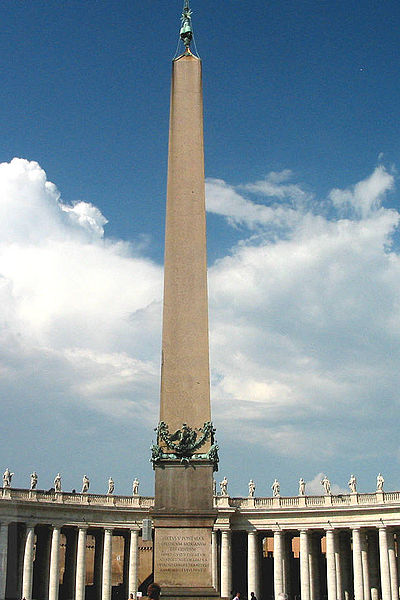
Originally raised in the Forum Iulium in Alexandria by the prefect Cornelius Gallus on Augustus's orders around 30–28 BC. No hieroglyphs. Brought to Rome by Caligula in 37 for the spina of Nero's (Vatican) Circus. Relocated by Pope Sixtus V in 1586 using a method devised by Domenico Fontana; the first monumental obelisk raised in the modern period, it is the only obelisk in Rome that has not toppled since Roman times. During the Middle Ages, the gilt ball on top of the obelisk was believed to contain the ashes of Julius Caesar. Fontana later removed the ancient metal ball, now in a Rome museum, that stood atop the obelisk and found only dust. Pedro Tafur in his Andanças (circa 1440) mentions that many passed between the ground and the "tower" basis "thinking it a saintly thing".
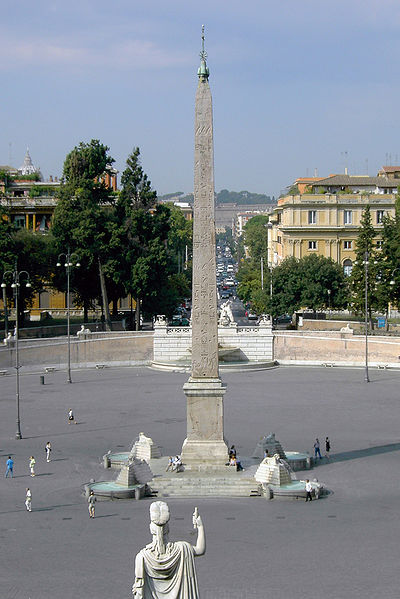
Originally from Heliopolis. Brought to Rome by Augustus in 10 BC with the Solare obelisk and erected on the spina of the Circus Maximus. Found with the Lateranense obelisk in 1587 in two pieces and erected by Pope Sixtus V in 1589. Sculptures with lion fountains were added to the base in 1818.

Originally from Heliopolis. Brought to Rome by Augustus in 10 BC with the Flaminio obelisk to form the gnomon of a sundial on the Campus Martius. Found in 16th century but reburied. Rediscovered and erected by Pope Pius VI in front of the Palazzo Montecitorio in 1792.
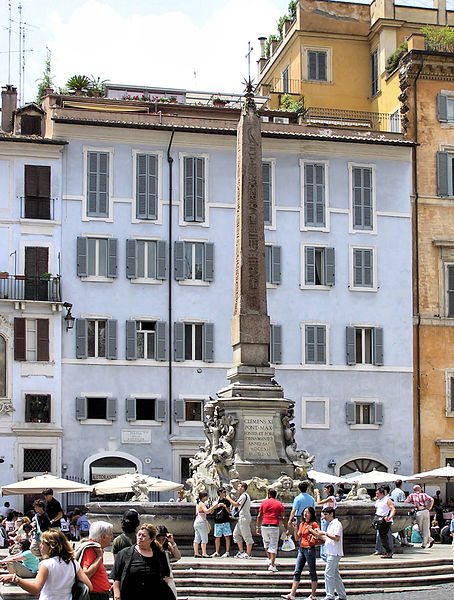
One of a pair from the Temple of Ra in Heliopolis, the other being the now much shorter Matteiano. Moved to the Temple of Isis near Santa Maria sopra Minerva. Found in 1373 near San Macuto and erected east of Santa Maria in Aracoeli on the Capitoline. Moved much reduced in size to the front of the Pantheon by Pope Clement XI in 1711 over a fountain by Filippo Barigioni.
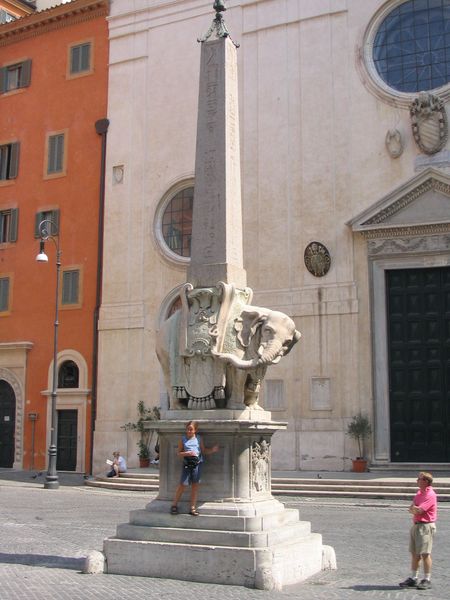
As a pair from Sais. Brought to Rome by Diocletian for the nearby Temple of Isis. Found in 1655 and erected in 1667 by Pope Alexander VII on an Elephant base by Bernini, behind the Pantheon on Piazza della Minerva. The other of the pair is in Urbino.
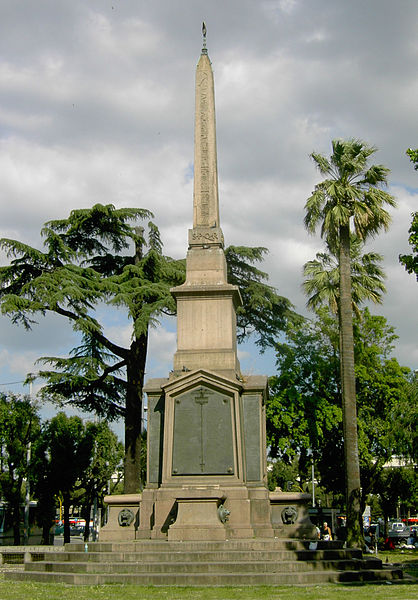
Originally from Heliopolis, the other now in the Boboli Gardens in Florence. Moved to the Temple of Isis in Rome. Found in 1883 by Rodolfo Lanciani near Santa Maria sopra Minerva. Now commemorates the Battle of Dogali, originally in front of Near Termini Station and moved to its present site in 1924.

Originally one of a pair at the Temple of Ra in Heliopolis, the other being the Macuteo which retains much more of its original height. Moved to the Temple of Isis near Santa Maria sopra Minerva. Found in the 14th century and erected east of Santa Maria in Aracoeli on the Capitoline. Moved to Villa Celimontana after Michelangelo redesigned the square in the late 16th century. Lost again; fragments rediscovered and re-erected in 1820. Smallest obelisk in Rome.
Imperial Roman Copies
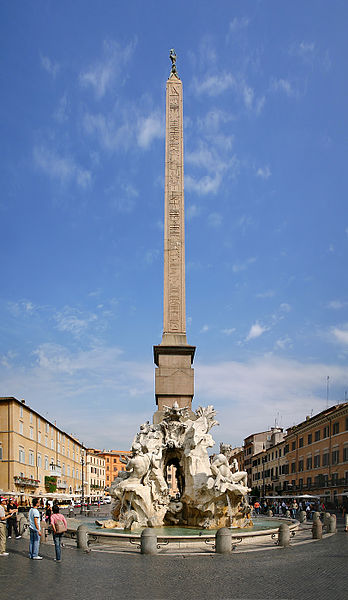
A copy commissioned in Egypt by Domitian and erected at the Temple of Serapis. Moved to the Circus of Maxentius by Maxentius. The Earl of Arundel paid a deposit and attempted to ship the four pieces to London in the late 1630s but Urban VIII disallowed its export. Erected on top of the Fontana dei Quattro Fiumi by Bernini in 1651.
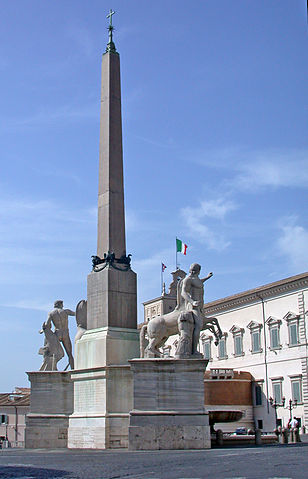
Originally erected on the eastern flank of the Mausoleum of Augustus, paired with the Esquiline obelisk. Found in 1527. Erected by Pope Pius VI

Originally erected on the western flank of the Mausoleum of Augustus, paired with the Quirinale obelisk. Found in 1527 and erected in 1587 by Pope Sixtus V behind Santa Maria Maggiore.
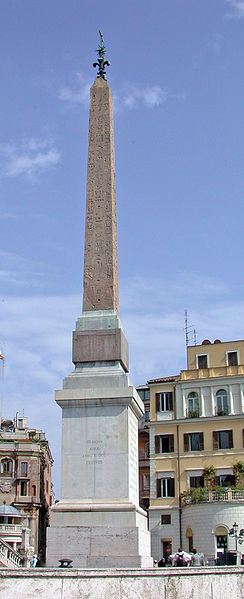
Above the Spanish Steps. An Aurelian copy, although smaller, of the Flaminio obelisk of Ramses II in the Piazza del Popolo, for the Gardens of Sallust. Found by the Ludovisi and moved to the Piazza di San Giovanni in Laterano in 1734, but kept horizontal. Erected in 1789 by Pope Pius VI.

Commissioned by Hadrian and erected in Tivoli for the tomb of Antinous. Moved to Rome by Elagabalus to decorate the spina of the Circus Varianus. Found in the 16th century near the Porta Maggiore. Moved to the Palazzo Barberini, then moved to the Vatican by Pope Clement XIV; finally erected on the Pincian by Pope Pius VII in 1822.
Not an obelisk but more interesting than all obelisks - (how many of us can read hieroglyphics?)
Trajan's
Column
Foro
Trajano near Piazza Venetia,
118
AD
|
|
|
The column commemorates Emperor Trajan's victory in the Dacian Wars. It was probably constructed under the supervision of the architect Apollodorus of Damascus at the order of the Roman Senate. It is located in Trajan's Forum, near the Quirinal Hill, north of the Roman Forum. Completed in AD 113 , the freestanding column is most famous for its 90-m long spiral bas relief, that describes the epic wars between the Romans and Dacians (101–102 and 105–106). Its design has inspired numerous victory columns, both ancient and modern.
The structure is about 30 meters high. The shaft is a hollow tube with a spiral staircase inside assembled from 20 colossal Carrara marble drums with a diameter of 3.7 metres. In 1587 the top was crowned by Pope Sixtus V with a bronze figure of St. Peter, which remains to this day.